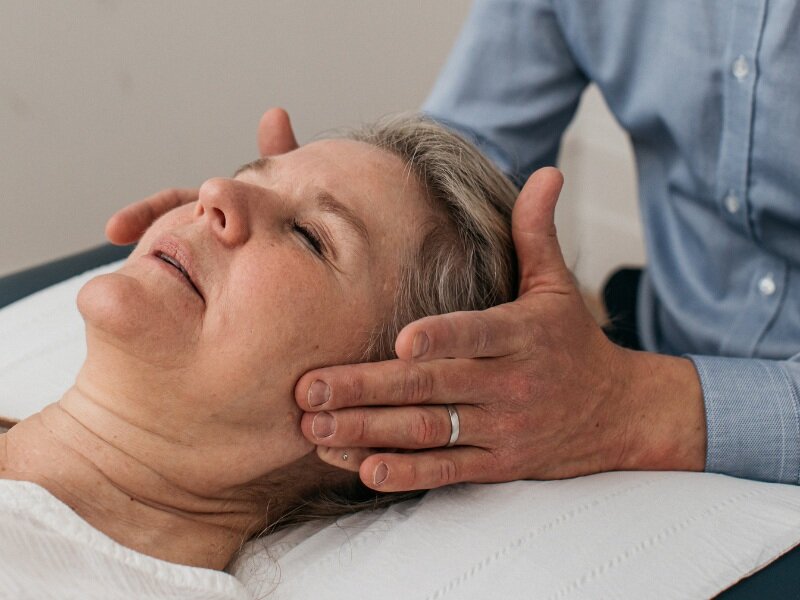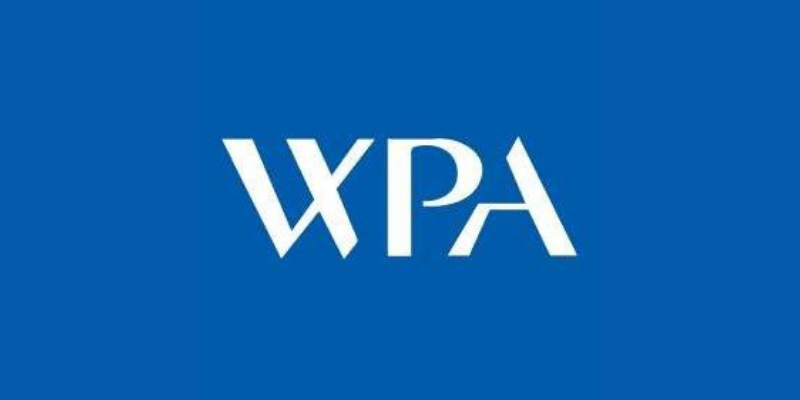Cranial Osteopathy for TMJ
Jaw pain can be more than just uncomfortable. It can affect your eating, sleeping, speaking, and even thinking. You might be feeling frustrated. Maybe you’ve tried mouth guards, seen dentists, and taken medication, and yet the pain keeps coming back. We hear this all the time. If you're suffering from TMJ issues, you're not alone, and there is help available. At Wellthy Clinic, we specialise in a gentle, whole-person approach to treating TMJ dysfunction. Book a free 15 minute discovery call to explore how we can help.
What is the TMJ?
The temporomandibular joint (TMJ) is the joint that connects your jawbone to your skull. You have two joints located on either side of your head. Both joints work together, along with ligaments, muscles, nerves and discs which allow you to speak and chew food. It is a hinge joint which allows for the opening and closing action of the mouth. Between this hinge joint is an articular disc which allows for a smooth jaw movement.
What is TMD?
TMD is a collective term that includes disorders of the TMJ, of the masticatory muscles and their associated structures in the absence of a visceral pathology (for example ear disorder, pharyngeal tumour or dental abscess). It is characterised by pain, joint sounds and restricted mandibular movements. Moreover, pain can refer to your mouth, face, head or neck. This is known as temporomandibular disorder (TMD).
What are the symptoms?
The most common TMD symptoms are jaw pain, clicking and popping sounds when moving your jaw. Locking out of your jaw, pain or difficulty chewing and yawning. You can also experience headaches, migraines, inability to open your mouth fully, difficulties swallowing and ear pain. Furthermore you can experience referred pain in your head, neck and shoulders.
What causes TMD?
There are multiple possible causes for your TMD so it is essential to diagnose correctly to give you the best chance of a long-term relief of your symptoms. We have divided our causes into three categories.
1 – Derangement of the Condyle-disc complex
‘Derangement of the condyle-disc complex’ might sound intimidating, but think of it like a slightly off-track door hinge that creaks, doesn’t move smoothly, and eventually causes other problems. For example, disc displacements can occur due to the change of function of the lateral pterygoid muscle after a trauma. This can lead to clicking when opening or closing your mouth. Disc displacements can also lead to disc dislocations.
2 – Structural incompatibility with articular surfaces
Changes in the smooth sliding surfaces can cause alterations resulting in friction and affecting joint function. Structural incompatibility is classified as a deviation in form, adhesions, subluxation, and spontaneous dislocation (Mani & Dua, 2021). History of dental work or osteopathy and orthodontics, nutrition deficiencies such as vitamin D or magnesium deficiency or low calcium consumption. Past history of head trauma, such as suffering from a broken nose as a child, could be contributing factors.
3 – Inflammatory disorders of the TMJ
Inflammatory conditions within the joint could be caused by direct trauma, such as jaw or head injuries, whether it is a fall, sports injury, or a traffic accident with whiplash.
Excessive psychological stress or anxiety has been linked with teeth grinding (bruxism) or clenching.
Synovitis – Inflammation of the synovium or the joint capsule.
Retrodiscitis – Swelling of retrodiscal tissues, and acute malocclusion are associated with the disease.
Osteoarthritis Alternative Treatment – inflammation due to increased overload of the joint. Over time, the forces will soften the articular surfaces and affect the subchondral bone.
Systemic arthritis – traumatic arthritis, infectious arthritis and rheumatoid arthritis can have an effect.
Can an Osteopath Help With TMJ?
Yes, our Cranial Osteopath is trained in diagnosing and treating TMD to help reduce your symptoms. Osteopathy for TMJ aims to restore function and reduce pain. Osteopaths are well known to treat the whole person and posture. In our experience, treating not only your jaw but also your neck, Cranial Osteopath for Back Pain, head, shoulders, and overall posture will achieve the best results.
“I avoided surgery thanks to cranial osteopathy.
I had been experiencing jaw pains and headaches for years. Having seen a number of therapists, I was recommended to have surgery. I’m in my late twenties and really thought there must be another way. I was intrigued to see if Cranial Osteopathy could potentially help, as this wasn’t something I had previously heard about or tried. I went into the appointment trying to be open minded but at the same time a little sceptical given the amount of previous practitioners I had seen before. After 2 treatments my jaw pains and headaches reduced dramatically. I feel really supported with Eleonora’s care who has encouraged me to take proactive steps to help reduce my symptoms.”
TMJ Treatment London
TMJ Osteopathy will involve cranial osteopathy and/or muscular stretching, joint articulations, and joint manipulations (if appropriate). You will also be advised on stretching and strengthening rehab exercises. You may also be offered nutrition and/or lifestyle top-tips to help optimise your recovery.
“I contacted Wellthy Clinic as I had been struggling with jaw pains, headaches and neck pains for 5 years. I had previously tried seeing everyone! Chiropractors, acupuncturists, dentists, massage therapists, physiotherapists, osteopaths, specialists and even maxillofacial surgeon to gain some relief. I was given mouth guards, specific exercises, medications and botox injections. Some gave me some short term relief for a few days maybe a week but then the pains would return. I was referred for surgery but really wanted to avoid this as I was convinced there had to be another way. Whilst internet researching I came across Cranial Osteopathy and thought why not, nothing to lose, everything to gain. Matthew was professional, he informed me on how past injuries, stress and postural issues could have an affect to my symptoms. He explained the treatment process was very different from other therapies and was worth trying to help reduce symptoms. The first session we talked about my history and then he treated my head. I couldn’t believe it although he didn’t move his hands I felt so many sensations throughout my head including a nice warm feeling. It was subtle but immediately following the session I felt my jaw relax. My headaches intensity and frequency reduced over the week. I started with some specific home based stretches which seemed to be useful. After receiving 6 sessions over 8 weeks I am pain free and have made the decision to not have surgery. Thank you and I really do recommend Wellthy Clinic.”
How does TMD Affect The Entire Body?
TMD pain can refer to your mouth, face, neck, shoulders and upper back. This will have a dramatic effect on the rest of your posture and fascia through altered muscular and joint function. For example if you have TMD this can affect the surrounding areas like your neck and potentially the whole of your posture. This is why treating your whole posture and encouraging Pilates rehab exercises can achieve great results.
How Wellthy Clinic can help with TMJ?
As a condition with many contributing factors, we find the best results are achieved from an integrative approach combining hands-on Osteopathy, Cranial Osteopathy, Paediatric Osteopathy, Nutrition and Pilates. We would create a course of treatment and regularly review and reevaluate it when needed. If symptoms are still being experienced (albeit reduced), it might be worth considering speaking to a talking therapist or seeing a dentist as well (if you haven’t tried already). Having a well-rounded approach provides you with the best management plan.
Can an Osteopath help with Jaw Pain?
Yes, but it depends on the cause. If stress and anxiety are the contributing factors, then in our experience, Cranial Osteopathy can help reduce your symptoms. It can be deeply relaxing, serving as a great circuit breaker to turn down your fight or flight response and help ease tensions. If there are joint or postural restrictions, such as osteopathy for neck pain contributing to your TMD, hands-on treatment can be particularly beneficial. In a recent study, Cranial Osteopathy were an effective treatment in patients with TMD (Gesslbauer et al, 2018).
What do TMJ headaches feel like?
Typically, they feel dull and aching, sometimes throbbing. You may experience headaches on one side of the head, although both sides can be affected. Jaw movement often aggravates the pain, while relaxation may provide relief. In some cases, TMJ-related headaches can resemble migraines, and this is where seeking migraines osteopathy treatment in London can be particularly helpful, as gentle hands-on techniques may ease tension and improve jaw function.
What causes TMJ to flare up?
Stressful lifestyle episodes can cause teeth grinding and contribute to TMJ flare-ups.
What is the Best Way to Get Rid of TMJ?
At Wellthy Clinic, we believe a combined approach of hands-on Osteopathy can help reduce the severity or frequency of your symptoms. TMD is a common presentation for adults and children, and we believe we can help you. We also treat babies with breastfeeding and cranial osteopathy issues and much more. Still not 100% sure about cranial treatment? How does cranial osteopathy work?
From experience, cranial osteopathy is a suitable treatment for TMD, as our client testimonials show.
Our Osteopaths are qualified and registered with the General Osteopathic Council. We are fully insured and recognised with AVIVA, Healix, Vitality, Cigna, Simply Health, Healthshield & WPA health insurance companies.
References
Gesslbauer et al (2018) Effectiveness of osteopathic manipulative treatment versus osteopathy in the cranial field in temporomandibular disorders – a pilot study Disability Rehabilitation
Mani & Dua (2021) Temporomandibular Joint Syndrome Stat Pearls.
A Clinic Director, TMJ specialist and cranial Osteopath (MSCCO) with extensive experience treating people with TMD.








